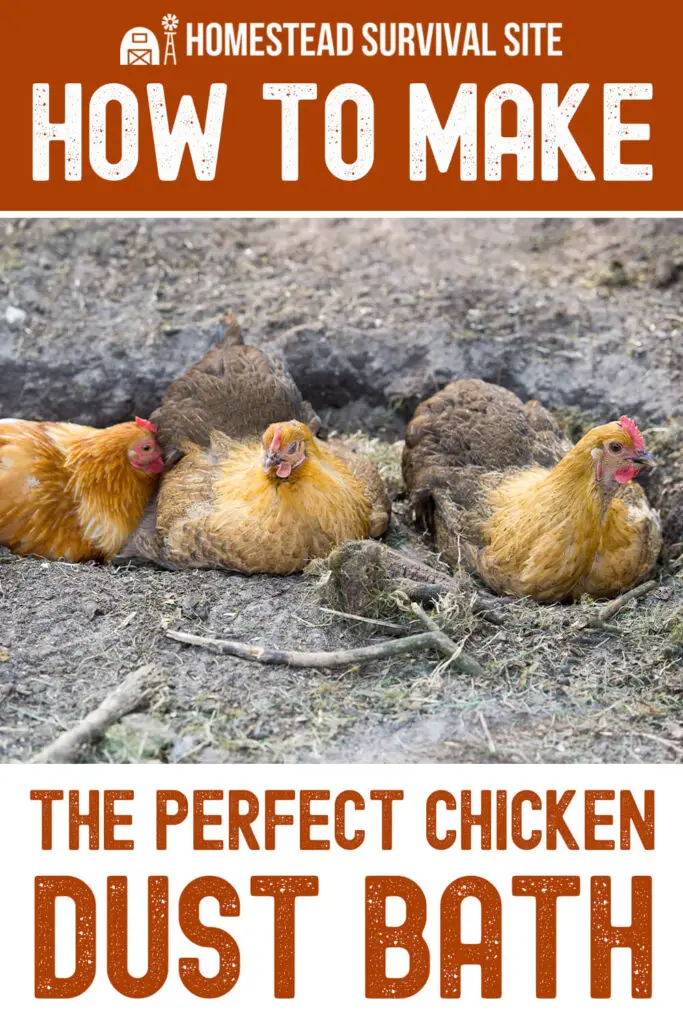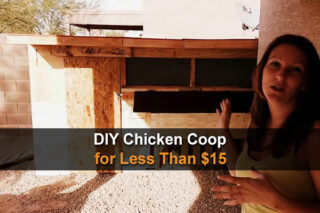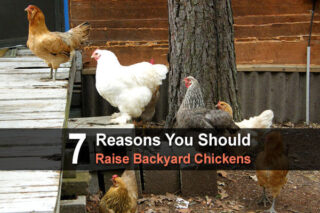Estimated reading time: 7 minutes
Have you ever found yourself staring at your chickens and wondering if there was something missing in their life? If they don't have a dust bath, then there is something missing!
Chickens need a good spa day just like the rest of us, and there's no better way to give them what they need than by providing them with a dust bath.
In this guide, we'll show you exactly how to make the perfect chicken dust bath that will have your chooks rolling around in pure delight. Let's get started.
Want to save this post for later? Click Here to Pin It On Pinterest!
What is a Chicken Dust Bath?
Are you a proud chicken owner or looking to become one? Either way, you may have heard of a chicken dust bath. But what is it exactly?
First, it's important to understand chickens don't actually take baths like we do, in water. They prefer to clean themselves with dust and dirt. They literally roll around in dirt, sand, or other fine materials.
Why do chickens do this? It turns out that a dust bath is actually an essential part of a chicken's hygiene routine. By rolling around in the dirt, a chicken is able to help remove excess oil, dirt, and parasites from its feathers and skin.
The importance of dust baths for chickens cannot be overstated. As they scratch and dig their way into the dirt, they create a small depression that becomes their personal spa spot. They flap their wings, roll around, and cover themselves in dust, creating a cloud that might make us humans sneeze but leaves the chickens feeling refreshed and rejuvenated.
Chickens need access to a dust bath all year round, regardless of the temperature or weather conditions. When it's cold outside, chickens will often huddle together inside the chicken coop, but they'll still need to be able to access their dust bath area.
Why Do Chickens Need a Dust Bath?
Here are a few reasons why you might want to consider adding a dust bath for your chickens if you haven't already.
To Control Oil
Chickens naturally produce oil on their skin and feathers, called sebum. Too much sebum can lead to clogged pores, and this can negatively impact the chicken's skin and feathers' health.
A dust bath, however, can help chickens keep their sebum levels in check. When they roll around in the dust, it absorbs the excess oil and dirt that the chickens may have accumulated on their feathers.
Parasite Prevention
Even backyard chickens are susceptible to a variety of parasites. These parasites can be a headache for chicken owners and have an impact on their chickens' health. Parasites like lice and mites can nest in a chicken's feathers, causing them to become irritated and itchy.
A dust bath can help prevent these pesky critters from taking up residence on your chickens by suffocating them in a suffocating cloud of dust. Chickens will instinctively seek out a dust bath when they are infested or feeling itchy, so if you notice your chickens rolling around more than usual, it's time to take action.
For Skin Health
Chickens' skin is incredibly sensitive, and prolonged exposure to damp or dirty environments can lead to a range of skin infections and diseases. A dusty environment, however, can help keep bacteria and fungi at bay, and the dry dust can help keep skin healthy.
A good dust bath routine can help prevent common skin diseases like bumblefoot, a painful foot infection that can be caused by damp or dirty living conditions.
Community-Building and Social Bonding
A dust bath isn't just essential for chickens' physical needs; it's also vital for their social needs. Chickens are incredibly social creatures and will often engage in communal dust baths. This is incredibly cute to watch, as the chickens will pile on top of each other in a big fluffy ball, all squawking and grooming themselves in a show of solidarity.
An Escape from the Heat
Chickens are much more temperature-sensitive than humans, and extreme heat can be disastrous for them. A good dust bath can help chickens cool down by providing them with a shady, dry refuge from the heat. This is especially important for chickens in hotter climates or during the summer months when temperatures can soar.
It's Fun!
Chickens are curious and inquisitive creatures, and dust baths provide them with an opportunity to engage with their environment and exercise their natural instincts. Watching a chicken roll around in the dust with complete abandon is a joyous sight for sure – and a reminder of how simple pleasures can sometimes be the most important ones.
How to Make a Dust Bath: Step by Step Guide
You'll want to start by finding the perfect location. Your chickens are picky about their dust bath location, so choose wisely.
Make sure the spot is sunny and dry, but with the option of partial shade for those scorching hot days. And most importantly, avoid areas prone to erosion or getting muddy. Nobody likes a soggy dust bath.
You may also want to consider giving your chickens multiple dust bathing spots to choose from. This way, they can pick and choose their ideal location depending on the weather and their mood. Plus, multiple areas mean less crowding and more peace in the flock.
On that note, know that size matters. The area should be large enough to accommodate three to four chickens at a time, depending on the flock size. You can use crates, shallow boxes, plastic totes, feeding tubs, or even old containers or flower pots for containment.
Now that you've chosen your location and contained the area, it's time to fill it up with dirt. Not just any dirt will do. It needs to be loose and dry to maximize the dust bathing experience. We'll talk in more detail about the options for filling your dust bath next, but for now, know that pure dirt is essentially all you need.
Depending on the material you use to contain your dust bath, you may want to add drainage holes before you fill it. This will prevent the container from getting waterlogged or soggy if it rains. You may also want to consider building a cover over the dust bath area to keep it nice and dry. Don't go too crazy with this – you don't want too much shade – but this can help protect the dust bath from the elements.
What is the Best Material for a Chicken Dust Bath?
Sand and dirt are the most common choices for a chicken dust bath. They are readily available and provide a good medium for chickens to roll and scratch in. Sand is especially good for chickens who are prone to mites or lice because it is abrasive and can help to remove these pests from their feathers.
Diatomaceous Earth (DE) is another popular choice for controlling external parasites. However, you should use it with caution because its fine silica particles can cause lung irritation if inhaled in large amounts. A sprinkle or two in the dust bath area will do.
Adding peat moss to clay-based soil is also a good idea as it will help keep the dust bath dirt light and aerated, which makes it easier for chickens to move around in. Sulfur dust is an effective way to control external parasites and can also be added as an amendment to the dust bath mixture.
You can also add herbs like thyme, garlic, borage or mint to the dust bath. This will repel pests and make the dust bath even more effective.
When it comes to ratios, there is no set rule. You can experiment with different ratios to find what works best for your flock. A good place to start is with equal parts of sand and dirt, and then add other amendments as desired.
Keeping Your Dust Bath Clean
Take the time to do a quick check-up on your dust bath every now and then. Remove any manure, rocks, or other foreign objects that may have made their way inside.
You should also refill the bath with fresh sand and soil as needed. Chickens can be quite messy, flinging dirt and sand all over the place, so don't be surprised if you notice the level getting low. Keep it topped up for their leisure and enjoyment.
Final Thoughts
Creating and maintaining a clean dust bath is the key to keeping your chickens healthy and happy. Even if your chickens have already set to work creating their own dust bath areas in the run, it's not a bad idea to DIY one like this to keep everyone happy, healthy, and occupied.
So, grab your shovel and get to work!
Like this post? Don't Forget to Pin It On Pinterest!
You May Also Like:











